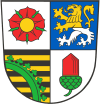Altenburger Land
| Altenburger Land | ||
|---|---|---|
| District | ||
| ||
 | ||
| Country |
| |
| State | Thuringia | |
| Capital | Altenburg | |
| Government | ||
| • District admin. | Uwe Melzer (CDU) | |
| Area | ||
| • Total | 569.41 km2 (219.85 sq mi) | |
| Population (31 December 2017)[1] | ||
| • Total | 90,650 | |
| • Density | 160/km2 (410/sq mi) | |
| Time zone | UTC+01:00 (CET) | |
| • Summer (DST) | UTC+02:00 (CEST) | |
| Vehicle registration | ABG, SLN | |
| Website | altenburgerland.de | |
Altenburger Land is a district in Thuringia, Germany. It is bounded by (from the west and clockwise) the district of Greiz, the Burgenlandkreis (Saxony-Anhalt), and the districts Leipzig, Mittelsachsen and Zwickau in Saxony.
History
The region on the Pleiße River was part of a huge forest, where the Thuringii formed the Thuringian Kingdom. After this was in 531 taken over by the Franks, Slavic people were also moving in. Thuringians reestablished independent rule. The castle of Altenburg already existed in the 10th century, it became an imperial seat. In the following centuries German settlers from other parts moved in. It was part of the Margravate of Meissen in the 14th century. At this time most of the forests were cleared.
The town of Altenburg and the surrounding lands were the tiny Duchy of Saxe-Altenburg from 1826 to 1918; afterwards it was a state within the Weimar Republic for a short time, before it was dissolved in 1922 in order to join the Free State of Thuringia.
The district in its present borders was established in 1922 under the name "Altenburg". In 1952 there was an administrative reform splitting the districts into two smaller units, called "Altenburg" and "Schmölln". They were merged again in 1994, but now under the name Altenburger Land.
Geography
Altenburger Land is the easternmost district of Thuringia. It is a mainly agricultural region. The main river is the Pleiße, a tributary of the White Elster, crossing the district from south to north. The hilly Osterland constituting the northernmost foothills of the Ore Mountains slopes gently away to the plains of eastern Saxony-Anhalt.
Coat of arms
 |
The coat of arms displays:
|
Towns and municipalities
| Verwaltungsgemeinschaft-free towns | and municipalities |
|---|---|
| Verwaltungsgemeinschaften | ||
|---|---|---|
| ||
| 1seat of the Verwaltungsgemeinschaft | ||
References
| Wikimedia Commons has media related to Landkreis Altenburger Land. |
External links
- Official website (German, English, French)